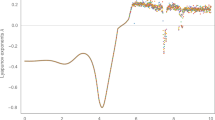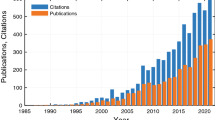Abstract
The strong interest in recent years in analyzing chaotic dynamical systems according to their asymptotic behavior has led to various definitions of fractal dimension and corresponding methods of statistical estimation. In this paper we first provide a rigorous mathematical framework for the study of dimension, focusing on pointwise dimensionσ(x) and the generalized Renyi dimensionsD(q), and give a rigorous proof of inequalities first derived by Grassberger and Procaccia and Hentschel and Procaccia. We then specialize to the problem of statistical estimation of the correlation dimension ν and information dimensionσ. It has been recognized for some time that the error estimates accompanying the usual procedures (which generally involve least squares methods and nearest neighbor calculations) grossly underestimate the true statistical error involved. In least squares analyses of ν andσ we identify sources of error not previously discussed in the literature and address the problem of obtaining accurate error estimates. We then develop an estimation procedure forσ which corrects for an important bias term (the local measure density) and provides confidence intervals forσ. The general applicability of this method is illustrated with various numerical examples.
Similar content being viewed by others
References
R. Badii and A. Politi, Statistical description of chaotic attractors: The dimension function,J. Stat. Phys. 40:725–750 (1985).
M. F. Barnsley and S. Demko, Iterated function systems and the global construction of fractals,Proc. R. Soc. Land. A 399:243–275 (1985).
C. Beck, Upper and lower bounds on the Renyi dimensions and the uniformity of multifractals,Physica D 41:67–78 (1990).
R. Benzi, G. Paladin, G. Parisi, and A. Vulpiani, On the multifractal nature of fully developed turbulence and chaotic systems,J. Phys. A: Math. Gen. 17:3521–3531 (1984).
P. J. Bickel and L. Breiman, Sums of functions of nearest neighbor distances, moment bounds, limit theorems, and a goodness-of-fit test,Ann. Prob. 11:185–214 (1983).
P. Billingsley, Hausdorff dimension in probability theory,Illinois J. Math. 4:187–209 (1960).
P. Billingsley, Hausdorff dimension in probability theory II,Illinois J. Math. 5:291–298 (1961).
P. Billingsley,Ergodic Theory and Information (Krieger, New York, 1978).
J. R. Blum, H. Chernoff, M. Rosenblatt, and H. Teicher, Central limit theorems for interchangeable processes,Can. J. Math. 10:222–229 (1958).
R. Bowen and D. Ruelle, The ergodic theory of Axiom A flows,Invent. Math. 29:181–202 (1975).
R. Cawley and R. D. Mauldin, Multifractal decompositions of Moran fractals, Preprint (1990).
Y. S. Chow and H. Teicher,Probability Theory: Independence, Interchangeability, Martingales, 2nd ed. (Springer-Verlag, New York, 1988).
P. Collet. J. L. Lebowitz, and A. Porzio, The dimension spectrum of some dynamical systems,J. Stut. Phys. 47:609–644 (1987).
C. D. Cutler, The Hausdorff dimension distribution of finite measures in Euclidean space,Can. J. Math. 38:1459–1484 (1986).
C. D. Cutler, Connecting ergodicity and dimension in dynamical systems,Ergodic Theory Dynam. Syst. 10:451–462 (1990).
C. D. Cutler,kth nearest neighbors and the generalized logistic distribution, inThe Logistic Distribution, N. Balakrishnan, ed. (Marcel Dekker, New York, 1991).
C. D. Cutler, A dynamical system with integer information dimension and fractal correlation exponent,Commun. Math. Phys. 129:621–629 (1990).
C. D. Cutler, Measure disintegrations with respect toσ-stable monotone indices and the pointwise representation of packing dimension, Preprint (1990).
C. D. Cutler and D. A. Dawson, Estimation of dimension for spatially-distributed data and related limit theorems,J. Multivariate Anal. 28:115–148 (1989).
C. D. Cutler and D. A. Dawson, Nearest neighbor analysis of a family of fractal distributions,Ann. Prob. 18:256–271 (1990).
M. Denker and G. Keller, Rigorous statistical procedures for data from dynamical systems,J. Stat. Phys. 44:67–93 (1986).
B. Dubuc, J. F. Quiniou, C. Roques-Carmes, C. Tricot, and S. W. Zucker, Evaluating the fractal dimension of profiles,Phys. Rev. A 39:1500–1512 (1989).
J.-P. Eckmann and D. Ruelle, Ergodic theory of chaos and strange attractors,Rev. Mod. Phys. 57:617–656 (1985).
J. H. Elton, An ergodic theorem for iterated maps,Ergodic Theory Dynam. Syst. 7:481–488 (1987).
C. Essex, Correlation dimension and data sample size, Preprint (1987).
C. Essex, T. Lookman, and M. A. H. Nerenberg, The climate attractor over short time scales,Nature 326:64–66 (1987).
K. J. Falconer,The Geometry of Fractal Sets (Cambridge University Press, Cambridge, 1985).
J. D. Farmer, E. Ott, and J. A. Yorke, The dimension of chaotic attractors,Physica D 7:153–180 (1983).
P. Grassberger, Are there really climate attractors?,Nature 322:609–612 (1986).
P. Grassberger and I. Procaccia, Characterization of strange attractors,Phys, Rev. Lett. 50:346–349 (1983).
P. Grassberger and I. Procaccia, Measuring the strangeness of strange attractors,Physica D 9:189–208 (1983).
P. Grassberger, R. Badii, and A. Politi, Scaling laws for invariant measures on hyperbolic and nonhyperbolic attractors,J. Stat. Phys. 51:135–178 (1988).
H. S. Greenside, A. Wolf, J. Swift, and T. Pignataro, Impracticality of a box-counting algorithm for calculating the dimensionality of strange attractors,Phys. Rev. A 25:3453–3456 (1982).
J. Guckenheimer, Dimension estimates for attractors,Contemp. Math. 28:357–367 (1984).
T. C. Halsey, M. H. Jensen, L. P. Kadanoff, I. Procaccia, and B. I. Shraiman, Fractal measures and their singularities: The characterization of strange sets,Phys. Rev. A 33:1141–1151 (1986).
M. Hénon, A two-dimensional mapping with a strange attractor,Commun. Math. Phys. 50:69–77 (1976).
H. G. E. Hentschel and I. Procaccia, The infinite number of generalized dimensions of fractals and strange attractors,Physica D 8:435–444 (1983).
J. Holzfuss and G. Mayer-Kress, An approach to error estimation in the application of dimension algorithms, inDimensions and Entropies in Chaotic Systems: Quantification of Complex Behavior, G. Mayer-Kress, ed. (Springer-Verlag, New York, 1986).
F. Ledrappier and M. Misiurewicz, Dimension of invariant measures for maps with exponent zero,Ergodic Theory Dynam. Syst. 5:595–610 (1985).
G. Mayer-Kress, ed.,Dimensions and Entropies in Chaotic Systems: Quantification of Complex Behavior (Springer-Verlag, New York, 1986).
R. H. Myers,Classical and Modern Regression with Applications (Duxbury Press, Boston, 1986).
C. Nicolis and G. Nicolis, Is there a climatic attractor?,Nature 311:529–532 (1984).
E. Ott, W. D. Withers, and J. A. Yorke, Is the dimension of chaotic attractors invariant under coordinate changes?,J. Stat. Phys. 36:687–697 (1984).
N. H. Packard, J. P. Crutchfield, J. D. Farmer, and R. S. Shaw, Geometry from a time series,Phys. Rev. Lett. 45:712–716 (1980).
G. Paladin and S. Vaienti, Hausdorff dimensions in two-dimensional maps and thermodynamic formalism,J. Stat. Phys. 57:289–299 (1989).
G. Paladin and A. Vulpiani, Anomalous scaling laws in multifractal objects,Phys. Rep. 156:147–225 (1987).
J. Pickands III, Moment convergence of sample extremes,Ann. Math. Stat. 39:881–889 (1968).
J. B. Ramsey and H.-J. Yuan, The statistical properties of dimension calculations using small data sets,Nonlinearity 3:155–176 (1990).
D. A. Rand, The singularity spectrumf(α) for cookie-cutters,Ergodic Theory Dynam. Syst. 9:527–541 (1989).
C. A. Rogers,Hausdorff Measures (Cambridge University Press, Cambridge, 1970).
W. Rudin,Real and Complex Analysis, 2nd ed. (McGraw-Hill, New York, 1974).
X. Saint Raymond and C. Tricot, Packing regularity of sets inn-space,Math. Proc. Camb. Phil. Soc. 103:133–145 (1988).
F. Takens, Detecting strange attractors in turbulence, inLecture Notes in Mathematics, 898 (Springer-Verlag, Berlin, 1981), pp. 366–381.
F. Takens, On the numerical determination of the dimension of an attractor, inLecture Notes in Mathematics, 1125 (Springer-Verlag, Berlin, 1985), pp. 99–106.
S. J. Taylor, The measure theory of random fractals,Math. Proc. Camb. Phil. Soc. 100:383–406 (1986).
C. C. Taylor and S. J. Taylor, Estimating the dimension of a fractal,J. R. Stat. Soc., to appear.
S. J. Taylor and C. Tricot, Packing measure, and its evaluation for a Brownian path,Trans. Am. Math. Soc. 288:679–699 (1985).
S. J. Taylor and C. Tricot, The packing measure of rectifiable subsets of the plane.Math. Proc. Camb. Phil. Soc. 99:285–296 (1986).
Y. Termonia and Z. Alexandrowicz, Fractional dimension of strange attractors from radius versus size of arbitrary clusters,Phys. Rev. Lett. 51:1265–1268 (1983).
C. Tricot, Rarefaction indices,Mathematika 27:46–57 (1980).
C. Tricot, Two definitions of fractional dimension,Math. Proc. Camb. Phil. Soc. 91:57–74 (1982).
C. Tricot, J. F. Quiniou, D. Wehbi, C. Roques-Carmes, and B. Dubuc, Evaluation de la dimension fractale d'un graphe, Preprint (1987).
L.-S. Young, Dimension, entropy, and Lyapunov exponents,Ergodic Theory Dynam. Syst. 2:109–124 (1982).
Author information
Authors and Affiliations
Rights and permissions
About this article
Cite this article
Cutler, C.D. Some results on the behavior and estimation of the fractal dimensions of distributions on attractors. J Stat Phys 62, 651–708 (1991). https://doi.org/10.1007/BF01017978
Received:
Revised:
Issue Date:
DOI: https://doi.org/10.1007/BF01017978




